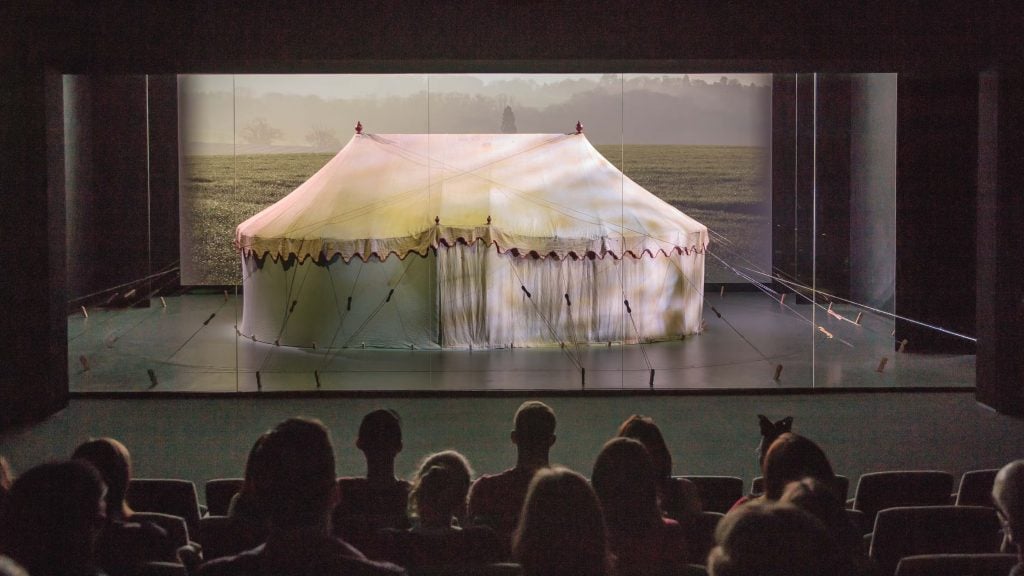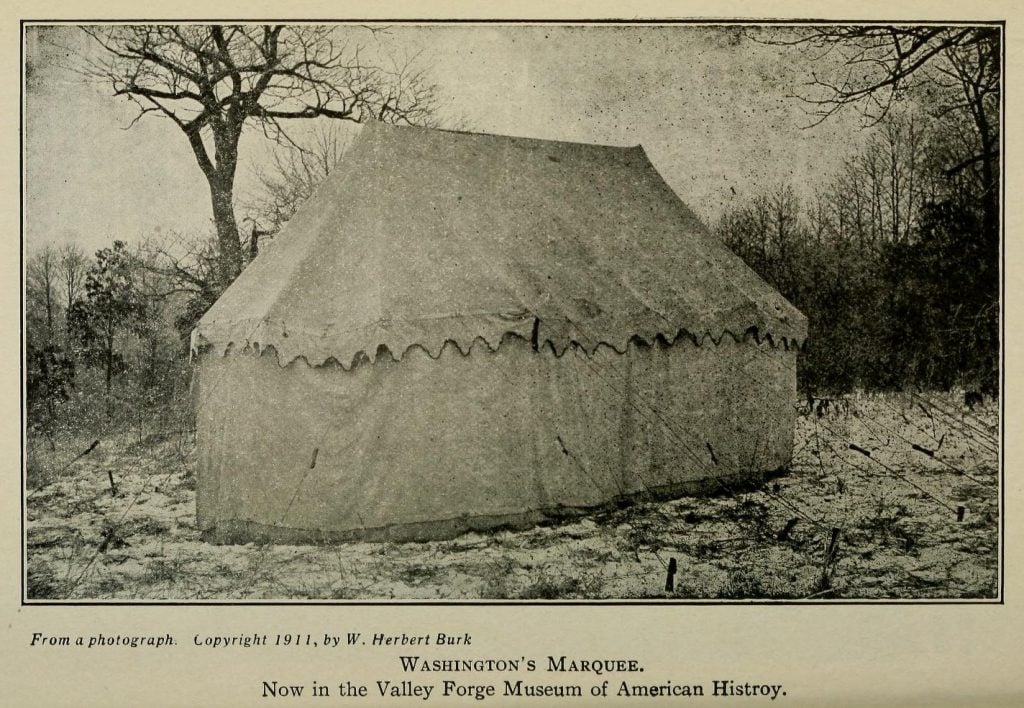As any savvy thrifter knows, you can find all sorts of treasures at the Goodwill—including, believe it or not, a piece of George Washington’s tent.
Collector Richard “Dana” Moore was understandably skeptical when he saw the online listing auctioning a purported scrap of the nation’s first president’s Revolutionary War tent back in 2022.
“There are a lot of fakes out there. There’s always something that’s not real, that looks to be real,” he told CNN. But after two weeks’ hesitation, “I jumped in with both feet. I said, ‘Hell with it.’ I’m gonna bid on it.”
Moore won the auction, paying just over $1,700 for the tiny fragment of faded white linen, about four by five inches with red trim. The lot included a handwritten note claiming the artifact had been shown in a 1907 exhibition celebrating the 300th anniversary of the founding of Jamestown, the first permanent English settlement in the U.S.
At first, Moore hid the purchase from his wife, unsure if it had been money well spent. But after conferring with experts at the Museum of the American Revolution in Philadelphia, which owns Washington’s war tent, he’s convinced he has a sliver of the genuine article—and that it’s likely worth tens of thousands of dollars.
A tiny scrap of George Washington’s Revolutionary War tent purchased at Goodwill is now on view at the Museum of the American Revolution. Photo courtesy of the Museum of the American Revolution.
The war tent, where Washington met with military officers by day and slept by night, is a 23-foot-long, 14-foot-wide, 12-foot-tall oval structure. Made of flax linen, it has a scalloped red trim.
It would have been quite “spartan” compared to the war tent of a 19th-century monarch, Museum of the American Revolution president R. Scott Stephenson told Smithsonian Magazine.
Based on careful examination by a conservator, the institution believes that the hand stitching on Moore’s Goodwill find is a match not to the war tent, but a second tent that would have served as Washington’s dining room.
“What’s really fascinating about this particular fragment is it retains some of the red wool trim on the edge of it, and that was telling us that this was likely cut away from the edge of the roof of the dining marquee,” Matthew Skic, the curator of exhibitions, told CNN.

The receipt for George Washington’s war tents, written by Plunket Fleeson, May 4, 1776. George Washington Papers, Manuscript Division, Library of Congress.
Washington first used the tents as his mobile field headquarters at Valley Forge in the spring of 1778. Until his death in 1799, the structures were stored at his home in Mount Vernon, Virginia. Washington had no children of his own, so George Washington Parke Custis, the grandson of Martha Washington and her first husband, Daniel Parke Custis, inherited the tents.
The younger Parke Custis used to regularly set up the tents during parties. He was also known to cut off scraps that he gave away as souvenirs. As the young nation grew, the tents acquired an almost mythic status. In 1824, on the occasion of Revolutionary War hero Marquis de Lafayette’s return to the U.S. from France, the war tent traveled to Fort McHenry in Baltimore.
Reunited with other surviving Continental officers inside the structure, Lafayette and the others assembled shed “tears of glory, gratitude, and joy,” according to an account from future president John Quincy Adams.
The Museum of the American Revolution is currently holding an exhibition marking the 200th anniversary of that visit. The show reunites all the known fragments of the tents—including Moore’s newly discovered scrap, the only one in private hands.

George Washington’s Revolutionary War tent at the Museum of the American Revolution. Photo courtesy of the Museum of the American Revolution.
“This one is a lot of fun because it came from an unlikely spot,” Skic said. “You don’t expect to find these kinds of historical treasures in a place like that, although this is not the first historical treasure that has come up via Goodwill.”
“People need to see it,” Moore told the Philadelphia Inquirer. “It’s the real deal.”
The dining tent is now part of the collection of the Smithsonian National Museum of American History in Washington, D.C., where it is not currently on view. The war tent, meanwhile, made something of a roundabout return to Pennsylvania.
George Washington Parke Custis passed the tents along to his daughter, Mary Anna Randolph Custis, and her husband, Confederate General Robert E. Lee. The Union seized their Arlington estate and its contents during the Civil War and put the tents on view in a “Captured at Arlington” exhibition in Washington, D.C. Their daughter Mary Custis Lee secured their return in 1901, after a prolonged legal battle. (The estate is now Arlington National Cemetery.)
The tents’ modern history begins in 1907, when Custis Lee loaned them to the Jamestown exhibition. That’s when a mysterious figure named John Burns—the person who signed the note that came with the Goodwill fragment—appears to have walked off with a cutting.
“We’re trying to figure out more about this person John Burns and his relationship to the exhibition,” Skic told PBS. “We’re still actively trying to figure out more of the context surrounding this ‘borrowing’ of a fragment of George Washington’s dining marquee.”
How the fragment came to be donated to the Goodwill remains a mystery.

A 1911 public domain photograph by Reverend W. Herbert Burk of George Washington’s Revolutionary War tent.
But after the Jamestown show, Custis Lee donated the tents to a benefit sale for the Home for Needy Confederate Women in Richmond. The war tent’s buyer was Reverend W. Herbert Burk, who spent two years raising money to fund the purchase. He envisioned the tent as the centerpiece of national museum dedicated to the founding of the nation.
To that end, Burk founded the Valley Forge Historical Society in 1918, which in the year 2000 established the Museum of the American Revolution. The institution opened its doors in 2017, and displays the tent in pride of place, in a dedicated theater. It is unveiled only after a dramatic 12-minute video, the “rock-star object,” of the collection, as the New York Times described it.
The tiny scrap Moore got from the Goodwill is less visually impressive, but it is nonetheless an important part of the narrative of the founding of our country.
“The discovery of this fragment adds to our understanding of the growth of Washington’s tents as symbols of the fragile American experiment in liberty, equality, and self-government,” Skic told the Independent. “The tents, and each fragment of them, serve as tangible links to the founding of the United States. They help us realize the hard work and perseverance that was required to create this nation and is still required to safeguard its future.”
“Witness to Revolution: The Unlikely Travels of Washington’s Tent” is on view at the Museum of the American Revolution, 101 South 3rd Street, Philadelphia, Pennsylvania, February 17, 2024–January 5, 2025,
Follow Artnet News on Facebook:
